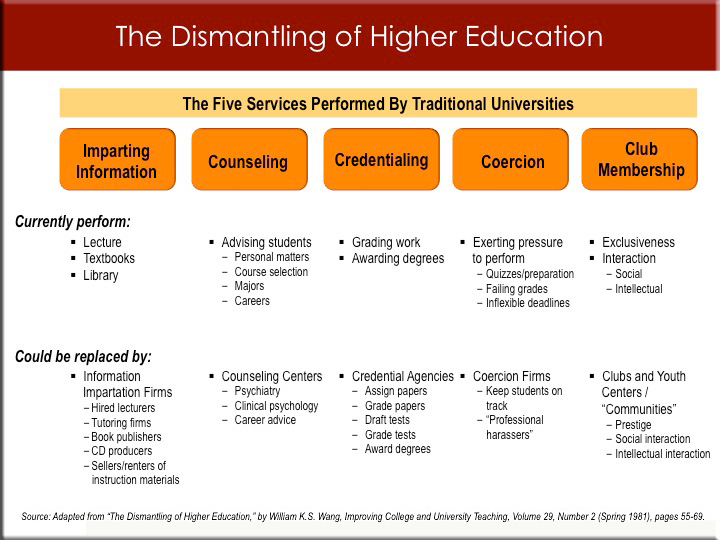I’m grateful for the following comments on this blog from Professor William K.S. Wang from earlier today:
I have published three articles on the unbundling of higher education (the first in 1975; most are available through an internet search): “The Unbundling of Higher Education,” 1975 Duke Law Journal 53. “The Dismantling of Higher Education,” published in two parts in 29 Improving College and… Read more University Teaching 55 (1981) and 29 Improving College and University Teaching 115 (1981) “The Restructuring of Legal Education Along Functional Lines,” 17 Journal of Contemporary Legal Issues 331 (2008)(discusses legal education, but applies to higher education generally); abstract below
THE RESTRUCTURING OF LEGAL EDUCATION, by William K.S. Wang
ABSTRACT
Currently, law schools tie together five quite distinct services in one package, offered to a limited number of students. These five functions are: (1) impartation of knowledge, (2)counseling/placement, (3) credentialing (awarding grades and degrees), (4) coercion, and (5) club membership. Students do not have the opportunity to pay for just the services they want, or to buy each of the five services from different providers.
This article proposes an “unbundled” system in which the five services presently performed by law schools would be rendered by many different kinds of organizations, each specializing in only one function or an aspect of one function. Unbundling of legal education along functional lines would substantially increase student options and dramatically increase competition and innovation by service providers. This offers the hope of making available more individualized and better instruction and giving students remarkable freedom of choice as to courses, schedules, work-pace, instructional media, place of residence, and site of learning. Most importantly, this improved education would be available on an “open admissions” basis at much lower cost to many more individuals throughout the nation, or even the world.
In order to explain how to restructure the existing law school system, this article will discuss the five educational services presently performed by law schools, the disadvantages of tying these services together, a hypothetical unbundled world of legal education, the advantages of the unbundled system, answers to some possible objections to the system, and some recent developments in the use of technology and distance learning in law schools.
The main theme of this article is the advantage of unbundling. A more modest sub-theme is the benefit of use of technology and distance learning.
Also see:
- Unbundling. . . and Reinforcing the Hierarchy? — from insidehighered.com by Margaret Andrews
. - Foundations of Strategy, Part 3: Technology — from insidehighered.com by Margaret Andrews
Excerpt:
Interestingly, this was predicted awhile back, in a 1981 article titled “The Dismantling of Higher Education,” by William K.S. Wang (Improving College and University Teaching, Volume 29, Number 2, Spring 1981, pages 55-69). In the article, Wang discusses five primary services performed by traditional universities – imparting information, counseling, credentialing, coercion, and club membership – and how they are currently performed by traditional universities. . . and how they might be replaced. Here is a brief synopsis of Wang’s idea:
.
Also relevant/see:
- Video and the learning playlist — from TrainingIndustry.com by Kaliym Islam
Excerpt:
You sign up for a course in order learn something new. The first half of the course contains background and overview information that is of no value to you. The next 25% goes over topics that you already know, while the next 15% finally provides you with the information or practice that you were looking for. But, the final 10% of the course simply recaps everything that was already covered. While you do derive some value from the experience, it comes at the expense of time wasted on the 85% of the course that didn’t.
…
Imagine how the learning experience would be different if there was an environment that allowed you to preview and extract small or “micro” learning objects from any course or curriculum that existed within that learning ecosystem.
From DSC:
More choice. More control. That’s one piece of the puzzle — i.e. where higher education is heading.










